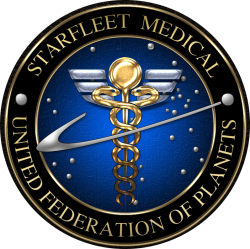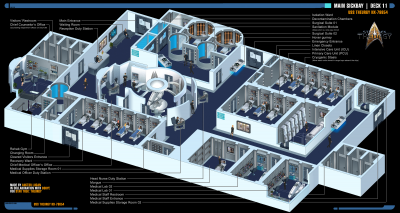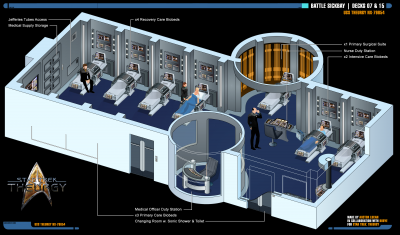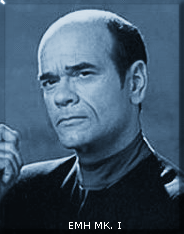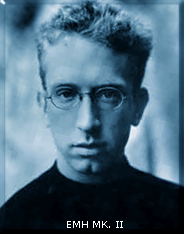Medical
From Star Trek: Theurgy Wiki
Starfleet Medical was a department composed of officers and crewmen trained to maintain and treat the crew's physical and psychological conditions, however, there were also several investigative members working in the research area.
Based out of San Francisco on Earth, Starfleet Medical oversaw all Starfleet medical personnel and facilities, which included exercising co-authority, besides the captain, over starship sickbay personnel. As its emblem, the department carried, from the mid-2150s onward, a stylized version of the double-snaked medical caduceus symbol from ancient Greek mythology. With the launch of the NX-class, Starfleet Medical asserted its co-authority over sickbay, by having its symbol prominently featured on the transparent access doors to sickbay, something repeated two centuries later with the Galaxy-class. In the 2270s and the 2280s (when the emblem was shortly replaced with a variant design), the emblem was worn by starship medical personnel on their garments when on duty in sickbay. Source: Memory Alpha
USS Theurgy Sickbay
Sickbay was an old Navy term for "ship's hospital", which continued even into the 24th Century.
Number of Primary Care Biobeds: 12
Number of Intensive Care Biobeds: 8
Number of Recovery Beds: 12
Number of Surgical Beds: 2
Number of Isolation Units: 1
Number of Decontamination Chambers: 2
Number of Medical Replicators: 7 (1 for each area except for the morgue)
Recovery Ward
Pretty much where you'd end up if your illness or injury was not too life-threatening but the doctor required you to hang around overnight for treatment and/or monitoring. Also was where non-critical patients were placed after surgery. Included 12 biobeds with overhead monitors, sanitized pillows and sheets for each bed, 1 replicator, and supply storage cabinet close by.
Primary Care Unit [PCU]
This was most likely where you'd be treated for bumps, bruises, common diseases, and anything else that didn't look to be particularly life-threatening. Included 12 scanning biobeds.
Intensive Care Unit [ICU]
Here's where you'd go if the doctors weren't sure whether you'd die soon or not and there was little more they could do about it but watch and wait. Each biobed was rigged for constant 3-dimensional scanning and monitoring of the patient. Included a computer link-up to an adjustable "Code Blue" alarm system that sounded the instant a patient's life-signs fell out of acceptable parameters. Also included 1 replicator, additional life support hardware for each bed, back-up battery power on a separate power grid from the ship, atmospheric isolation systems, and a supply storage closet that could be found near by.
Medlab 01 & 02
The primary laboratories for Sickbay's use. These included 1 replicator, material diagnostics stations, a centrifuge, gene analysis terminal, a table for post-mortum examinations, and stasis field drawers for storage of biological samples, corpses, or patients requiring treatment not available on the ship.
Surgical Suite 01 & 02
If you needed surgery to save your life, correct an illness, fix a serious injury, or to just have yourself cosmetically altered for an undercover assignment this was where they'd have you laid out. Along with the usual surgical tools, the room included a sanitation module, mobile life support equipment, a replicator, atmospheric isolation systems, and scanning/monitoring readout station.
Holographic Projection Grid
 The LMH |
LMH
The USS Theurgy was fitted with the EVE Program AK-1 DMSA-656, a Long-term Medical Holographic program. She was offline since the first encounter with the USS Calamity, and could only be re-activated after the Battle of Starbase 84. After the first encounter with the Savi, the LMH's subroutines were compromised and she remained deactivated. She was out of order until her holographic matrix could be repaired.
EMH Mk I & II
Two EMH programs were also available given the fact that the USS Theurgy could split into three during Multi-Vector Assault Mode. The EMH aboard were the Mark I and the Mark II. These programs could be activated to provide additional assistance to the real Medical Officers. The EMH were programmed with all current medical knowledge and had the ability to learn as required. Additionally, the EMH could take on any other medical role as required by the ship/facility.
Unlike previous EMH systems with primary emitters inset into the ceiling every 1.5 meters and larger back-up emitters inset into center of each ceiling over the Recovery Ward, Primary Care Unit, Medlab-1, and both operating rooms being fully integrated with Sickbay's computer hardware to prevent accidental loss of the EMH at critical moments, the Theurgy-class took the EMH one step further, having holo-emitters in every area of the ship, allowing the good doctors to venture outside of Sickbay to treat the wounded more efficiently just like the Ship AI Hologram.
Battle Sickbays
Because of the Theurgy's MVAM-mode, many main areas of the ship were duplicated, this included the Sickbay. Vector 02 and 03 sections both contained a full Sickbay. Vector 01's Sickbay (the saucer section) was the Main Sickbay area [discussed above], while the other two Vectors had one Battle Sickbay each. These were much larger than the Main Sickbay, and with its open layout that gave the medical personnel more freedom of moment, they were designed specifically for battle conditions.
Medical Equipment
Autosuture
An autosuture was a handheld unit used to heal reasonably mild wounds to the skin. Autosutures can be used to close incisions or heal knife wounds beyond the ability of a dermal regenerator. In 2369, an autosuture was used to heal a stab wound received by Captain Jean Luc Picard.
Biobed
The primary biobed in sickbay was designed for surgical purposes, although it was also the default bed for examinations conducted by medical personnel. It had various hookups for surgical equipment, and was typically covered by a large sensor cluster. Surgical beds usually had a large display for vital signs and other information adjacent to the bed. Serious surgeries usually required a larger biobed with more specialized sensors and surgical equipment.
Brain-circuitry Pattern
The brain-circuitry pattern was used as both a medical diagnostic tool as well as a means of identification as such patterns were unique to that individual. The scan created an image capable of mapping the neural activity in the brain.
Cardio-Inducer
The cardio-inducer was a medical device which was used to treat heart conditions in artificial hearts.
Cortical Stimulator
Cortical stimulators helped return the brain and nervous system to a normal, healthy state when a humanoid entered a coma or suffered other forms of serious neurological disturbance.
During treatment, doctors placed the unit on the patient's head. The stimulator's linear array of electromyonic sensors analysed the current level of neural activity and compared this activity to the normal parameters for the patient's species. Using these readings, the physician then activated the stimulator's network of phased muon projectors. Intersecting muon beams focused on individual neurons, stimulating them in patterns similar to normal brain activity. A sufficient level of neural stimulation usually resulted in the patient's other neurons adapting their firing to match this pattern, returning the patient to a normal state.
Doctors would carefully monitor the cortical stimulator or the patient could experience neural damage or seizures. In the hands of a skilled physician this device could even help cure complex neurological abnormalities like the Vulcan t'lokan schism or temporary insanity induced by drugs or stress. Doctors had occasionally used this device to reinforce normal neurological patterns to such a degree that noncorporeal beings inhabiting patients were expelled. On rare occasions when a patient's bioneural energy was temporarily displaced from the body, a cortical stimulator could keep the patient's body alive until this energy was returned.
Delta Wave Inducer
Physicians throughout the Federation used delta wave inducers to help patients enter a deep and restful sleep. Starfleet cadets and other students sometimes used inducers to get to sleep before an important performance review. Most humanoid brains oscillated in a certain range of resonance frequencies (known as delta waves) while asleep; this device artificially induced this state and eased the subject into sleep.
The delta wave inducer was a partial headband that fit comfortably over the user's forehead and temples. The device activated a series of superconducting nickel-rhombium zeta-meson projectors. The zeta-meson fields produced by the delta wave inducer oscillated in the same frequency as delta waves, and caused the neurons in the user's brain to fire in a similar pattern through mesonic induction. Within five minutes of activation, the user fell into a sound sleep. Normally, the unit turned itself off after ten minutes, although a physician could program it to keep the user asleep for a set period of time, waking him up by damping out the delta waves in his brain. Doctors advised healthy subjects who simply needed help getting to sleep not to use this unit more than twice a week to avoid psychological dependence.
Dermal Regenerator
A dermal regenerator was a common medical device used to heal minor wounds although major, gaping wounds and surgical incisions still required an autosuture. The dermal regenerator could also be used for cosmetic surgery such as removing scars as well as removing disguises created through the use of synthetic skin.
DNA Reference Scan
A DNA Reference Scan was a medical procedure to identify an individual by matching the DNA patterns with those on file.
Exoscalpel
Sometimes internal injuries or the presence of foreign bodies inside the patient required physicians to perform surgery. Based on principles similar to those used by multipurpose gravitonic effectors, exoscalpels were the 24th century surgical cutting device. This unit used trionic emitters to tightly focus a low-powered rapid nadion cutting beam.
Exoscalpels had two modes of operation. In the normal mode, a exoscalpel projected a linear nadion beam that functioned as an exceedingly thin blade. A surgeon could focus the beam as short as 0.1 cm or as long as 20 cm for exceptionally deep incisions. The trionic emitters could also focus the nadions at certain points along the beam. Since only focused nadions could slice tissue, a exoscalpel could cut deeply within a patient without actually piercing the skin or damaging any tissue between the exoscalpel and the affected region. This focused cutting area could extend up to 20 cm away from the unit and could focus as short as 0.1 cm or as long as 5 cm. If the surgical procedure required it, a strong electric charge carried by the trionic beam could instantly cauterize any incision this device made.
Like many instruments, exoscalpels had alternate uses. While this device was incapable of affecting refractory materials like tritanium or Duranium, an exoscalpel could easily cut all ordinary organic material like wood or bone, and most of the boronite whisker composites used in furniture and clothing.
Hyperencephalogram
A hyperencephalogram was a medical test involving an instrument capable of recording and measuring brain-wave activity.
Hypospray
A hypospray (colloquially, hypo) was a medical device used to inject liquids into the body. The system used a non-invasive transport mechanism of compressed air to transfer the injectant from the device into the body without the use of a needle, ensuring that the skin was not punctured during use, thus reducing the risk of infection. Various drugs could be used, inserted into the hypo in vials attached to the end of the instrument.
The 23rd century Federation hypospray resembled the intravenous needles of previous centuries, whilst the 24th century version of the device was more compact, employing an angled head and rounded tip to transfer the drug more easily. Controls at the injection head set the dosage to be injected.
The typical injection site used was the side of the neck, but the hypospray could inject even through clothing. Unlike hypodermic needles, the hypospray could be used on multiple patients without worries of spreading blood-borne illnesses.
K-3 Indicator
A K-3 Indicator was a medical diagnostic device on Starfleet biobeds that measured the neural activity which corresponded with the level of pain as it was being experienced by the patient.
Medical Kit
Medkits, also known as medikits, were pouches used by Starfleet medical practitioners and officers that contained medical equipment for away teams, containing a medical tricorder, a hypospray, a dermal regenerator, and a trauma kit for emergency medical situations. They were often kept in strategic positions around Starfleet vessels and bases.
Medical tricorder
The medical tricorder was a specialized version of the standard tricorder. It was equipped with sensors and analysis software tailored for medical diagnostic purposes. They were usually the first tool a Starfleet doctor utilized when assessing a patient's condition. Medical tricorders could function aboard ship in sickbay as well as on away missions.
Micro-Tone
A micro-tone was a device which could be used to make extremely precise cuts, such as trying to sever the spine, where a exoscalpel or sonic separator would create too coarse an incision.
Neural Bridge
The neural bridge was a medical device that could be used to stabilize the neural functions of a patient with heavy brain damage. It allowed the brain of a normal person to be used to support a damaged brain.
Neural Imaging Scan
The neural imaging scan was a medical diagnostic scan employed to test acuity of a patient's visual cortex.
Neural Stimulator
A neural stimulator was a medical instrument used to increase activity in the central nervous system of a dying humanoid brain.
Neural Transducer
Neural transducers were small devices used to restore mobility to physically disabled individuals. They could pick up the neural signals from the brain and then stimulate the appropriate muscles. The implants were generally not one hundred percent effective, but did allow a patient to recover most mobility. Motor assist bands were first used to train the patient's nervous system before surgery.
Optical Scanner
The optical scanner was used to perform diagnostics on the visual receptors by Engineering Officers. It could detect phase variances and alterations in the surrounding dekyon field.
Psychotricorder
A psychotricorder was a Federation instrument, similar to a tricorder, used to record past memories.
Retinal Imaging Scan
A retinal imaging scan enabled the Medical Officer to verify the presence or absence of visual cortex activity.
Sonic Separator
The sonic separator was a medical instrument commonly used to separate tissue, similar to a laser scalpel.
Surgical Support Frame
A key part of any surgical operation was the Surgical Support Frame or SSF, which was an attachable device to a Federation biobed. It was commonly called a "clamshell", given its shape and the fact that it was mounted over a patient during a surgical procedure. The SSF provided both a sterile environment and vital diagnostic and life support tools, such as a defibrillator and a pulmonary scanner. The frame incorporated a battery of bio-function sensors to supplement those of the biobed and overhead sensor clusters.
The SSF was capable of automated administration of intravenous medication as well as cardiovascular support and emergency defibrillation.
There were a variety of support frame types for different procedures and different body lifeform types. They were integral parts of any Surgical Bay.
Tissue Scanner
A tissue scanner was used to measure the rate of cellular decay. It could run scans at the molecular level, and was capable of picking up tetryon particles. The sensitivity could be boosted with an enhanced resolution mode, and could adjust the scan field as needed. The unit interfaced with remote computer systems, which could be used to control all functions.
Trilaser Connector
The Trilaser connector was a medical instrument used to reconnect nerve connections.
Vascular Regenerator
A vascular regenerator was a medical instrument used to repair blood vessels and stop bleeding without invasive surgery.
Drugs and Medicines
Analgesics
Asinolyathin: A pain reliever and muscle relaxant. It is used primarily to treat muscle spasms and pain from muscular injuries.
Bicaridine: A strong, addictive, pain reliever used to treat pain from traumatic injuries such as disruptor blasts. Is a known substitute for Metorapan.
Hydrocortilene: A pain reliever used primarily for cranial pains. A dose of 3% is sufficient for a mild headache, whereas increased doses were necessary for more debilitating injuries, such as concussion.
Metorapan: A formidable pain reliever used to treat more severe injuries. It is very similar to bicaridine, though without the risk of addiction. However it can cause fatal allergic reactions in around 1% of cases.
Morphenolog: A medication used primarily in the treatment for chronic pain. It can also be used in conjunction with other medications to reduce painful side effects.
Terakine: A pain relieving medication used to ease the pain from broken bones and similar injuries.
Triptacederine: A potent pain reliever used to aid with end-of-life pain. Another common application of the drug can be to ease the discomfort caused by malfunctioning cybernetic implants.
Anesthetics
Anesthizine: A fast-acting anesthetic typically deployed in a gaseous form. It was considered to be one of the best in use by the Federation.
Anetrizine: A local anesthetic deployed through a hypospray, typically used to numb specific nerves to remove sensation and induce paralysis.
Axonol: A gaseous anesthetic authorised for use by the Federation as a crowd-control measure.
Neurozine: A gaseous anesthetic that was fast acting and could be dispensed through the typical environmental control systems on a Federation Starship.
Antibiotics
Corophizine: An antibiotic used primarily in order to prevent secondary infections.
Burn Treatments
Dermaline: A drug typically administered as a pre-emptive injection when there was a risk of exposure to high level UV radiation.
Dermaline Gel: A thick white gel made from dermaline compounds that could be used to soothe and treat first and second degree burns.
Kelotane: A drug typically administered via hypospray that was used to treat severe burns that were caused by high levels of harmful radiation.
Cardiovascular
Adrenaline: A hormone and neurotransmitter that can be used to prevent anaphylaxis.
Alizine: A medicine used to counteract anaphylactic shock, specifically in Klingons.
Anticoagulant: A medicine administered to prevent or reduce the clotting of blood.
Cateline: A drug that could cause a simulated anaphylactic shock when administered.
Chloromydride: A strong cardiostimulant that was most commonly used when inaprovaline was ineffective. One application was to aid a patient undergoing cardiac arrest.
Cordrazine: A strong stimulant, primarily used to stimulate the heart during cardiac arrest.
Digoxin: A drug administered via hypospray that could be used to treat atrial fibrillation, atrial flutter, and heart failure. The drug was toxic in higher doses.
Inaprovaline: A synaptic stimulant and cardiostimulant that fortified the cell membranes and could be used as a preventative measure or in response to various physical illnesses and states.
Lectrazine: A drug that could be used to stabilise the cardiovascular system in the event of shock or disruption in normal cardiac functions.
Metrazene: A drug that could be used to treat cardiac arrhythmias.
Quadroline: An emergency resuscitative drug that was used to treat cardiac arrhythmias.
Stenophyl: A drug that could be used to treat anaphylactic shock.
Neurological
Alkysine: A drug that was used to reduce the damage caused to neurological tissue following the event of a catastrophic injury.
Cortical Analeptic: A type of drug administered via hypospray to reinvigorate tissue within the cerebral and motor cortex following disruptions to the neural functions.
Synaptizine: A drug used to treat neuroleptic shock.
Theragen Derivative: A compound that could be used to deaden nerve inputs into the brain, resulting in a calming effect on the patient and a reduction in emotions such as anxiety, stress and aggression.
Trianoline: A medicine used to help patients with percussive injuries in small doses; 0.4ccs was sufficient for a concussion.
Vertazine: A drug used for to aid recovery from severe dizziness and vertigo.
Radiation
Arithrazine: A medication used in extreme cases of theta radiation poisoning. It could also serve in the form of an inoculation. A medical officer was required to monitor a patient receiving arithrazine during treatment according to Starfleet medical protocol.
Analeptic Compound: A compound used to counter the detrimental effects of certain types of radiation, including theta radiation.
Hyronalin: A drug used to counter the effects of radiation poisoning. These effects can be enhanced when combined with lectrazine.
Recreational and Narcotic
Alcohol: A chemical that acted as a psychoactive drug with intoxicating effects when consumed, known to be addictive and to possibly result in poisoning when consumed in high quantities. It could also be used as a disinfectant and as an antiseptic gel.
Caffeine: A stimulant consumed in a variety of foods and beverages. If consumed regularly, it could become addictive, along with causing side effects such as insomnia, gastrointestinal distress and hypertension.
Felicium: An addictive narcotic that granted the user a euphoric sensation with both pain-relieving and sedative side effects. Serious withdrawal symptoms tended to occur within 72 hours.
Impedrezene: A narcotic that slowed down higher brain functions and affected motor function. Extreme headaches were commonly found when the effects wore off.
Ketracel-White: An addictive narcotic given to Jem’Hadar soldiers by the Dominion to provide an essential enzyme, as well as all the nutrients they required to survive.
Synthehol: A chemical that replicates the properties of alcohol, without the effects of intoxication, addiction, or poisoning.
Triglobulin: A drug used by some species as an aphrodisiac, though also had an application to aid in the facilitation of vaccinations and medicines.
Respiratory
Cortolin: A resuscitative drug that was primarily used in reviving patients who had stopped breathing.
Dexalin: A drug used in the treatment of oxygen deprivation.
Pulmozine: A drug used to treat oxygen deprivation and stimulate breathing.
Trioxin: A drug used in the treatment of respiratory injuries, though only appropriate in emergency situations as a stop-gap measure.
Resuscitative
Cortolin: A resuscitative drug that was helpful in reviving patients who had stopped breathing.
Leporazine: A resuscitative drug that had minimal chance of causing negative effects, but could not be administered to a patient with low blood pressure.
Morathial: A drug similar to leporazine, a series of which were almost as effective at resuscitating patients as the aforementioned drug, without the risks to the patient's blood pressure.
Netinaline: A stimulant that could be used to resuscitate a patient.
Quadroline: An emergency resuscitative drug that was used to treat cardiac arrhythmias.
Sedatives
Ambizine: An injectable drug that was used as a fast-acting sedative.
Anesthizine: A fast-acting anesthetic typically deployed as a gas. It was considered to be one of the best by the Federation.
Axonol: A gaseous anesthetic authorised for use by the Federation as a crowd-control measure.
Dylamadon: A sedative that could be used to simulate death in an individual.
Improvoline: A standard sedative that could be used in smaller doses, such as 5ccs, to calm and pacify a patient. Higher doses would be able to keep a patient sedated for longer periods of time.
Kayolane: A standard sedative that caused unconsciousness for several hours.
Melorazine: A standard sedative.
Merfadon: A less effective sedative that could be rendered inert depending on the diet of the patient.
Tetrovaline: A medical drug that renders a person unconscious, but also lowers immune response.
Stimulants
ADTH: A stimulant which could be dispersed in a gaseous form through the life support system of a typical Federation Starship.
Animazine Derivative: A stimulant that could be used to awaken someone from sleep, or keep them conscious for longer durations than naturally advised.
Chloromydride: A strong cardiostimulant that was most commonly used when inaprovaline was ineffective. One application was to aid a patient undergoing cardiac arrest.
Cordrazine: A strong stimulant, primarily used to stimulate the heart during cardiac arrest.
Cortropine: A stimulant found in standard-issue medkits which could stimulate the recipient to overcome symptoms of weakness or fatigue.
Dalaphaline: A systemic stimulant that can strengthen individuals after neurological.
Formazine: A stimulant that could be used to promote alertness and reduce fatigue, however in higher doses could cause restlessness and irritability.
Hyperzine: A standard stimulant that could be used to counter seizures.
Inaprovaline: A synaptic stimulant and cardiostimulant that fortified the cell membranes and could be used as a preventative measure or in response to various physical illnesses and states.
Masiform D: A powerful stimulant that could be used to counteract the effects of poisoning. It had a side effect of an upset stomach in Vulcans.
Polyadrenaline: A synthetic version of adrenaline that could be used as a stimulant which could aid the revival of a patient who had died or was near death.
Tricordrazine: A highly potent stimulant that could be used both to resuscitate and as an anti-seizure medication. However, doses higher than 10ccs were risky.
Misc
Benzocyatizine: A medication used to treat low isoboramine levels in Trill, which regulated the connection between symbiont and host.
Cervaline: A drug used to limit rejection of transplanted organs or tissue.
Dylovene: An antitoxin carried as standard in Starfleet medkits
Mirazine: A drug used to reduce the time necessary for decompression when boarding and leaving starships.
Priaxate: A drug used to lessen the symptoms of plague.
Stokaline: A multivitamin drug administered via injection.
Tesokine: A drug used to facilitate cross-species surrogacy.
Disclaimer Notice
- Starfleet Medical Emblem used with permission of Gazomg Art - granted Nov 24, 2016
- List of medical instruments used with permission of USS Wolff CO - granted Jan 30, 2017
- List of drugs and medications obtained using information from the public domain at Memory Alpha - obtained Oct 5, 2018
